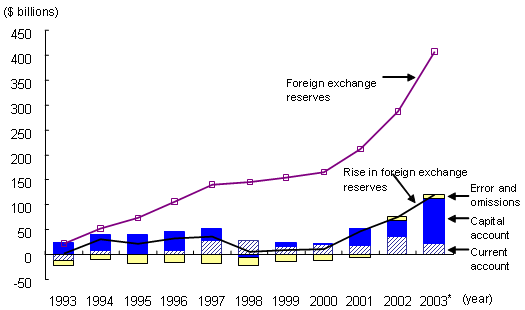China's foreign exchange reserves have been sharply increasing of late, and as of September 2003 the country had $383.9 billion in foreign exchange reserves, a level that placed it second in the world behind Japan. One reason for this is the fact that China is racking up huge surpluses in all major components of its balance of payments, such as its current account, which mainly shows trade, and its capital account, which includes direct investment. Furthermore, as shown by the fact that the margin of error and omissions in statistics has shifted from a deficit, which indicates capital flight, to a surplus, the influx through unofficial channels of speculative money in expectation of an appreciation of the yuan is also another reason behind the surge in foreign exchange reserves ( diagram 1 ). So long as flow - the international balance of payments - remains in the black, stock - foreign exchange reserves - will also continue to rise ( note ). Such an expansion in the imbalance is leading to a decline in the efficiency of resource distribution, economic overheating and trade frictions with other countries; and authorities are having difficulty dealing with the situation.
The increase in the external imbalance vividly shows that the current exchange rate is lower than its market equilibrium rate. China maintains that it adopts a managed float system, but the focus of this policy is on "management," and there has been virtually no "floating" in the yuan's exchange rate against the dollar since the Asian currency crisis of 1997. When, as is the case now, the yuan is comparatively undervalued against the dollar, the supply of dollars exceeds demand, and authorities must issue more yuan to absorb the excess dollars in the market in order to stabilize the exchange rate ( diagram 2 ). If China had been adopting a full-float system, the central bank would not intervene in foreign exchange markets, so that the level of foreign exchange reserves would remain unchanged, while the exchange rate would rise so as to secure a balance between a foreign currency's supply and demand instead.
When, as seen now, authorities try to forcibly maintain an exchange rate that keeps the yuan comparatively undervalued, China's foreign exchange reserves further increase, and the negative effects stemming from this are already becoming conspicuous. As a result of market intervention by authorities, foreign exchange reserves grow, but because they are invested in such foreign assets as U.S. Treasury Bonds, the hard currency so painstakingly earned is not used to develop the domestic economy and instead flows to foreign countries. Meanwhile, as a result of market intervention, domestic money supply increases, threatening to accelerate economic overheating. In order to absorb the liquidity brought about by market intervention, authorities are implementing sterilization policies such as open market operations to control money supply. Specifically, in addition to the central bank's selling of its short-term bond holdings to absorb yuan, from September 21 the reserve ratio for commercial banks was raised from 6% to 7%. However, as a result of sterilization measures, domestic interest rates are rising, further inducing the influx of hot money. Furthermore, should China do nothing to correct its trade imbalance with major trading partners, trade frictions could worsen. Pressure from the United States to appreciate the yuan may intensify, especially with the presidential election coming up next year.
To strive for foreign exchange stability and correct imbalances, authorities have adopted a series of measures to encourage the outflow of foreign currency and stem its influx while maintaining exchange rates through market intervention. First, as a step to encourage foreign currency to flow out of China, restrictions on foreign direct investment by domestic companies have been eased, and ceilings on currency exchange by individuals and their taking of foreign currency overseas have also been raised. In addition, China has dispatched missions to the U.S. to make emergency purchases of aircrafts and automobiles. At the same time, to control the influx of foreign currency, authorities have announced that from January 2004 the tax refund rates for value-added tax will be reduced by an overall average of three percentage points. While value-added tax currently stands at 17%, the refund rate is on average 15%, and the remaining 2% can be considered as an export tax. The upcoming reduction in the refund rate is equivalent to a hike in the export tax, and is expected to have a dampening effect on Chinese exports.
However, measures to encourage the outflow of foreign currency could exacerbate capital flight, and government intervention in the market through such means as emergency imports and raising the export tax could distort the allocation of resources. So long as such measures have these side effects, China should utilize the most direct and effective means to correct the imbalance, which is to adjust its exchange rate.
Diagram 1: China's rising external imbalance and foreign exchange reserves

(Note)Increase in foreign exchange reserves = current account balance + capital account balance + error and omissions.
* Figures for 2003 are estimated based on half-year figures.
(Source)State Administration of Foreign Exchange http://www.safe.gov.cn/ (Chinese only)
Diagram 2:The mechanism behind the rise in foreign exchange reserves

(Note)Measures to encourage an outflow of foreign currency can be shown by a shift of the demand curve to the right, while steps to control the inflow of foreign currency shift the supply curve to the left.


